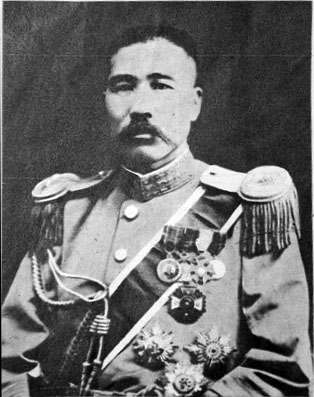
The Chinese Civil War was fought between the Kuomintang-led government of the Republic of China and the forces of the Chinese Communist Party (CCP), with armed conflict continuing intermittently from 1 August 1927 until Communist victory resulted in their total control over mainland China on 7 December 1949.

The Second Sino-Japanese War was fought between the Republic of China and the Empire of Japan between 1937 and 1945, following a period of war localized to Manchuria that started in 1931. It is considered part of World War II, and often regarded as the beginning of World War II in Asia. It was the largest Asian war in the 20th century and has been described as "the Asian Holocaust", in reference to the scale of Japanese war crimes against Chinese civilians. It is known in China as the War of Resistance against Japanese Aggression.

The Northern Expedition was a military campaign launched by the National Revolutionary Army (NRA) of the Kuomintang (KMT) against the Beiyang government and other regional warlords in 1926. The purpose of the campaign was to reunify China, which had become fragmented in the aftermath of the 1911 Revolution. The expedition was led by Generalissimo Chiang Kai-shek, and was divided into two phases. The first phase ended in a 1927 political split between two factions of the KMT: the right-leaning Nanjing faction, led by Chiang, and the left-leaning faction in Wuhan, led by Wang Jingwei. The split was partially motivated by Chiang's Shanghai Massacre of Communists within the KMT, which marked the end of the First United Front. In an effort to mend this schism, Chiang Kai-shek stepped down as the commander of the NRA in August 1927, and went into exile in Japan.

Yan Xishan was a Chinese warlord who served in the government of the Republic of China. He effectively controlled the province of Shanxi from the 1911 Xinhai Revolution to the 1949 Communist victory in the Chinese Civil War.

The Warlord Era was the period in the history of the Republic of China between 1916 and 1928, when control of the country was divided between former military cliques of the Beiyang Army and other regional factions. It began after the death of Yuan Shikai, the de facto dictator of China after the Xinhai Revolution had overthrown the Qing dynasty and established the Republic of China in 1912. Yuan's death on 6 June 1916 created a power vacuum which was filled by military strongmen and widespread violence, chaos, and oppression. The Nationalist Kuomintang (KMT) government of Sun Yat-sen, based in Guangzhou, began to contest Yuan's Beiyang government based in Beijing for recognition as the legitimate government of China.

The Northeastern Army, also known as the Fengtian Army, was a Chinese army that existed from 1911 to 1937. General Zhang Zuolin developed it as an independent fighting force during the Warlord Era. He used the army to control Northeastern China (Manchuria) and intervene in the national politics. During the mid-1920s the Northeastern Army was the dominant military force in China, but in 1928 it was defeated by the Kuomintang's National Revolutionary Army (NRA) during the Northern Expedition. At the end of that campaign, Zhang Zuolin was assassinated and succeeded by his son Zhang Xueliang. When Xueliang subsequently pledged loyalty to the Kuomintang, the Northeastern Army became part of the NRA and was officially rechristened the "Northeastern Border Defense Force".

The Central Plains War was a series of military campaigns in 1929 and 1930 that constituted a Chinese civil war between the Nationalist Kuomintang government in Nanjing led by Generalissimo Chiang Kai-shek and several regional military commanders and warlords who were former allies of Chiang.

The Pacification of Manchukuo was a Japanese counterinsurgency campaign to suppress any armed resistance to the newly established puppet state of Manchukuo from various anti-Japanese volunteer armies in occupied Manchuria and later the Communist Northeast Anti-Japanese United Army. The operations were carried out by the Imperial Japanese Kwantung Army and the collaborationist forces of the Manchukuo government from March 1932 until 1942, and resulted in a Japanese victory.

After the Japanese invasion of Manchuria, and until 1933, large volunteer armies waged war against Japanese and Manchukuo forces over much of Northeast China.
The Big Swords Society or Great Knife Society was a traditional peasant group most noted for the killing of two German Catholic missionaries at the Juye Incident in 1897 at Zhang Jia Village where the missionaries were ambushed in their sleep by about 30 armed men. The Big Swords Society was widespread in North China during the Qing Dynasty and noted for its reckless courage. Rather than one large overarching organization, the Big Swords were local groups of small-holders and tenant farmers organized to defend villages against roaming bandits, warlords, tax collectors or later the Communists and Japanese.

The Northeast Counter-Japanese United Army, also known as the NAJUA or Northeast Anti-Japanese United Army, was the main Counter-Japanese guerrilla army in Northeast China (Manchuria) after the Japanese invasion of Manchuria in 1931. Its predecessors were various Counter-Japanese volunteer armies organized by locals and the Manchuria branches of the Chinese Communist Party (CCP). In February 1936, the CCP, in accordance with the instructions of the Communist International, issued The Declaration of the Unified Organization of Northeast Counter-Japanese United Army and marked the official formation of the organization.
The campaign to suppress bandits in northeast China (东北剿匪) was a counterinsurgency operation waged by the Chinese Communist Party against bandits and guerrillas affiliated with the Kuomintang near the end of the Chinese Civil War.
The Zhucheng Campaign (诸城战役) was a campaign fought in Shandong, and it was a clash between the communists and the former nationalists turned Japanese puppet regime force who rejoined the nationalists after World War II. The battle was one of the Chinese Civil War in the immediate post World War II era, and resulted in communist victory.
The Korean Volunteer Army, was an armed wing of the Chosŏn Independence Alliance, formed in 1942 by reorganizing the North China branch of the Chosŏn Volunteer Corps. Based in Taihang Mountain, they fought an armed struggle against the Japanese until the end of World War II. They were disbanded and many of them were incorporated into the Korean People's Army. At the time of the establishment of the Democratic People's Republic of Korea, they were called the Yan'an faction, but were purged until 1958 after the Korean War.

The Warlord Rebellion in northeastern Shandong was an uprising of several allied Chinese warlord armies under the leadership of Zhang Zongchang in 1929. The rebels wanted to regain their former territories in Shandong from Liu Zhennian, the man who had defected from Zhang to the Nationalist government in Nanjing during the Northern Expedition. After some initial successes, the rebels were defeated due to the indiscipline of their forces. In the end, the uprising failed to topple Liu Zhennian's rule over eastern Shandong, but resulted in high civilian casualties and widespread destruction at the hands of both sides in the conflict.
The Fengtian clique's Zhili Army was a Chinese Warlord Era fighting force that controlled the Republic of China's Zhili province from 1924 until 1928, with the exception of a few months in 1925/26. Not related to the Zhili clique, it instead originated as Fengtian Second Army and operated as part of the Fengtian clique's armed forces. It was led by two successive Fengtian warlords, Li Jinglin and Chu Yupu, who always followed the orders of Zhang Zuolin, the Fengtian clique's overall leader. Although the Zhili Army's quality declined after 1925, it distinguished itself in numerous battles until it was disbanded in 1928 after being defeated by the National Revolutionary Army in the Northern Expedition.
The Red Spear Society staged a major uprising in 1928–1929 against the rule of Liu Zhennian, the Nationalist government-aligned warlord ruler of eastern Shandong province in Republican China. Motivated by their resistance against high taxes, rampant banditry and the brutality of Liu's private army, the Red Spear peasant insurgents captured large areas on the Shandong Peninsula and were able to set up a proto-state in Dengzhou county. Despite this, the whole insurgency was eventually crushed by Liu in late 1929.

The Yellow Sand Society, also known as Yellow Way Society, and Yellow Gate Society, was a rural secret society and folk religious sect in northern China during the 19th and 20th century.

The National Pacification Army (NPA), also known as the Anguojun or Ankuochun, was a warlord coalition led by Fengtian clique General Zhang Zuolin, and was the military arm of the Beiyang government of the Republic of China during its existence.

The Spirit Soldier rebellions of 1920–1926 were a series of major peasant uprisings against state authorities and warlords in the Republic of China's provinces of Hubei and Sichuan during the Warlord Era. Following years of brutal suppression, civil war, and excessive taxation, the rural population of central China was restive, and susceptible to militant salvationist movements. One spiritual group, the so-called Spirit Soldiers, promised the peasants that they could gain protection from modern weaponry through protective magic. Tens of thousands consequently rallied to join the Spirit Soldiers, and successfully revolted in the mountainous and isolated areas of Hubei and Sichuan. At its height, the Spirit Soldier movement numbered over 100,000 fighters, and controlled about forty counties.













